Spring Bugs
I consider spring hatches those from green up through the highwater, May through June.
This is the season that bug life becomes really interesting! There are many mayflies starting to move in the watercourse and other important bugs like caddis and stoneflies starting to appear "en mass".
Of course BWOs will still be around, as will many other bugs. This list is just a few of the basic, Must Haves.
Callibeatis
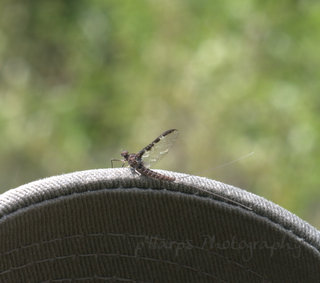
May to September
Swimming Nymph
Order: Ephemeroptera
Family: Baetis
Other Names: Speckled Dun
This is the most common mayfly available in lakes in Alberta. Hatches are present on slow weedy sections of Rivers and most lakes.
Hatches will begin in May and continue through the summer, while the mayflies will get progressively smaller in size.
Peak hatches occur in May to June and August to September. Hatches occur on warm afternoons and the duns are easily crippled by cool
wet weather. Spinner falls typically occur in the morning or late evening.
Seasonal Sizes of the Dun: May-June: size 10-12 ; July-Aug: size 12-14; Sept-Oct: size 14-16
Patterns:
Nymph: Hare’s Ear Nymph, Pheasant-tail Nymph (long and slender, brown, 12-16).
Emerger: Callibaetis Cripple, Soft-Hackle (grey, light brown, tan, 12-16).
Dun Adult: Parachute, Sparkle Dun, Thorax Dun (olive-brown or tan body, grey wing 16-24).
Spinner: Rusty Spinner, Sunk Soft-hackle (Tan or Brown 16-22).
Western March Brown
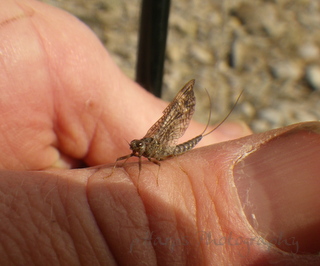
mid-May to mid-June
Clinger Nymph
Order: Ephemeroptera
Family: Heptageniidae
Genus: Rhithrogena
Other Names: Rhithrogena morrisoni, Western March Brown
Often the first large mayfly to hatch on rivers, this is the mayfly that represents the beginning of dry flies that you can actually see
on the water.
The March brown hatch normally occurs for a couple of hours, mid-day, with the spinner fall happening at the same time.
Patterns:
Nymph: Hare’s Ear Nymph, Pheasant-tail Nymph (bushy, brown, olive (10-14).
Emerger: Quigley Cripple, Soft-Hackle (brown, light brown, reddish-brown 10-14).
Dun Adult: Parachute, Sparkle Dun, Thorax Dun (brown body, grey wing 12-16).
Spinner: Poly-wing Spinner, Sunk Soft-hackle (Rust or Brown 12-16).
Pale Evening Dun
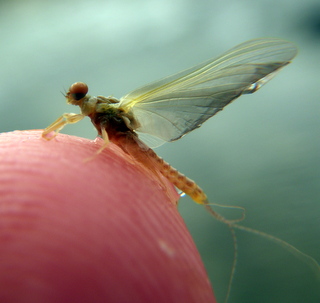
June-July and Late Summer and Fall
Clinger Nymph
Order: Ephemeroptera
Family: Heptagenia
Other Names: PED
The mayfly will hatch in lower streams in June-July and mountain streams through July and into August and September. They are found in fast flowing cobble sections. The nymphs tumble as they are poor swimmers and emergence typically occurs in slower waters on the edge of fast currents.
Patterns:
Nymph: Flat and wide, Hare’s Ear Nymph, Pheasant-tail Nymph (brown, olive (12-16).
Emerger: Quigley Cripple, Soft-Hackle (pale yellow or orange, light brown, olive-brown, 12-18).
Dun Adult: Parachute, Sparkle Dun, Thorax Dun (orange-yellow or olive-brown body, pale wing 14-18).
Spinner: standard Spinner, Sunk Soft-hackle (tan, pale yellow, yellow-orange, or yellow-green 14-18).
Mahogany Dun

Mid-April to June
Crawler Nymph
Order: Ephemeroptera
Family: Heptageniidae
Genus: Rhithrogena
Other Names: Paraleps, Red Quills, and Slate-Wing Duns
The Mahogany Dun is an important late season mayfly for western anglers. It is unpredictable but often provides one of the first and last
“fixes” for dry fly fishing.
Nymph patters should be tied slender as the Paraleps nymphs are streamlined swimmers. Paraleps swim to the surface and hatch while they float
downstream. A wet humid day will delay the hatch resulting in a longer opportunity for trout to take them on the surface, and therefore a better chance for
the dryfly angler. Duns and spinners are typically on the water from 10AM till early afternoon.
Patterns:
Nymph: Hare’s Ear Nymph, Pheasant-tail Nymph (slim, brown, rust (10-16).
Emerger: Quigley Cripple, Soft-Hackle (rust, brown, 12-16).
Dun Adult: Standard, Sparkle Dun, Thorax Dun (rust or brown body, grey wing 12-16).
Spinner: Poly-wing Spinner, Sunk Soft-hackle (Rust or Brown 12-16).
Pale Morning Dun

June to August
Crawler Nymph
Order: Ephemeroptera
Family: Ephemerellidae
Other Names: PMD
Don’t be fooled by the name, the Pale Morning Dun can hatch from 11Am to early evening throughout the early summer.
The PMD is one of the more important mayflies of southern Alberta. They hatch on most of the rivers, and in large enough numbers to trigger
surface feeding.
Unfortunately, PMD’s get smaller as the season progresses, initially hatching around size 14 and ending the season closer to size 18.
They are typically found in the medium to slow sections of rivers and will hatch be floating up to the surface in calm water.
Patterns:
Nymph: Hare’s Ear Nymph, Pheasant-tail Nymph (slim, yellow-brown, olive (12-16).
Emerger: PMD Quigley Cripple, Soft-Hackle (pale yellow, light brown, olive, 12-18).
Dun Adult: Parachute PMD, PMD Sparkle Dun, Thorax Dun (olive-yellow body, grey wing 14-18).
Spinner: Yellow Spinner, Sunk Soft-hackle (pale yellow or yellow-green 14-18).
Brown Drake
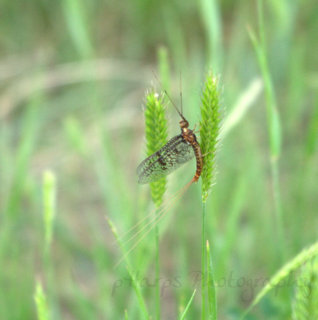
June to mid-July
Burrowing Nymph
Order: Ephemeroptera
Family: Ephemeridae
Genus: Ephemera
Other Names: Ephemera simulans
The Brown Drake is a large mayfly that hatches following the highwater events. The hatch typically occurs at sundown and duns and spinners may be on the water all night.Stream and river bottoms with mud, sand and gravel.
There are a few lower elevation places where this hatch is known to occur in Albreta.
Patterns:
Nymph: Hare’s Ear Nymph, Pheasant-tail Nymph (yellow-brown, (6-12).
Emerger: Quigley Cripple, Soft-Hackle (brown, light yellow- brown, 8-12).
Dun Adult: Paradrake, Parachute Hares Ear, Sparkle Dun, Comparadun, Thorax Dun (yellow-brown body, grey wing 8-12).
Spinner: Poly-wing Spinner, Sunk Soft-hackle (Brown 8-12).
Mothers Day Caddis
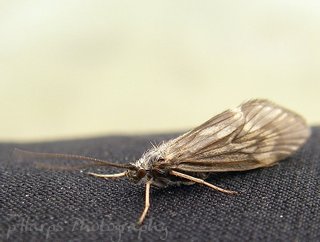
May-August
Order: Trichoptera
Family: Brachycentrus
Other Names: Grannoms, Brachycentrus
It starts with a short hatch in the spring, before runoff during the daytime. By Summer, Grannoms are everywhere.
Female will sit on the surface to deposit eggs, but occasionally will swim below.
Patterns:
Larva: Cased-Caddis (brown, 8-16), Brown Hare’s Ear (8-16).
Pupa: LaFontaine’s Deep Sparkle Pupa (brown, 8-16).
Adult: Stimulator, Elk Hair Caddis (orange, brown, 8-16).
Salmonflies
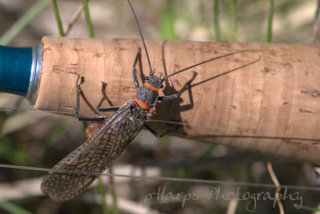
April-May
Family: Pteronarcys
Other Names: Meat
A large stonefly that shows up in mid May. The nymphs are available all year and the adults can be seen crawling up rocks and skittering across the river from mid-May through June. These are the big bugs that can be imitated with big foam patterns! Unfortunately, the peak hatch coincides with the peak flood.
Patterns:
Nymph: Kaufmanns Stonefly Nymph, AP Nymph, Brook's Stone (brown, 2-8).
Adult: Stimulator, Sofa Pillow, Chubby Chernobyl (olive, pink, oragge, tan, white wing 2-6).
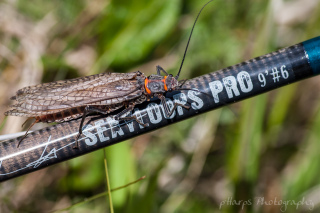
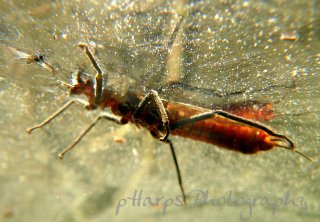
A great source for wing materials is the Silver Tip Fly Company. The small mayfly wings are visible on the water and translucent enough to let the light through.
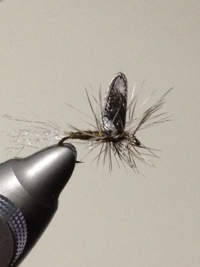
Coming soon, the Early Summer bugs!